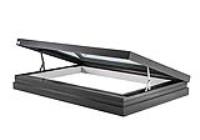 Add My Company
Add My Company
Sign In

Energy efficient glazing helps to reduce the amount of heat naturally lost through rooflights and windows.
Not only do double and triple glazed units help to keep the home warmer, they also reduce energy bills, reduce condensation build-up and provide insulation from external noise.
How does double-glazing work?
Double-glazed rooflights comprise of two sheets of glass, hermetically sealed with a spacer bar providing a cavity in between; this is designed to provide an insulating gap between the inside and outside panes of glass. The size of this cavity differs in width dependent on specification and thickness of the glass panes, but will usually be between 14mm-16mm in most modern applications.
Traditionally the cavity was air filled but in recent times you are far more likely to find the cavity filled with an inert gas, such as Argon. The benefit of using an Argon filled cavity is that it has approximately 34% lower conductivity than air, thus improving the thermal performance of the glazing unit. Krypton and Xenon gas are sometimes used and are more energy efficient, but are much more expensive in comparison.
So what is the difference between double and triple-glazed rooflights?
Triple glazed units use the same principals as double-glazing, but improve upon this performance wise by including three sheets of glass, with two Argon filled cavities in the sealed glazing unit instead of only one.
The way to compare the energy performance of any glass rooflight is to use the U value measurement; the lower the number, the better the insulation. A typical double-glazed unit will provide centre pane u-values of 1.1 W/m2k, whereas the equivalent triple glazed unit will provide superior values of 0.7 W/m2k.
Double glazed = 1.1 W/m2k
Overall thickness 28mm
Outer: 6mm clear toughened
Cavity: 16mm Argon filled with warm edge spacer
Inner: 6mm clear toughened soft low e
Triple glazed = 0.7 W/m2k
Overall thickness 48mm
Outer: 6mm clear toughened
Cavity: 14mm Argon filled with warm edge spacer
Middle: 6mm clear toughened soft low e
Cavity: 16mm Argon filled with warm edge spacer
Inner: 6mm clear toughened soft low e
In what situation would you use triple as opposed to double?
Triple glazing can be used in almost any application where you would normally consider double-glazing; with its superior U-values it is particularly suited to houses based in either cold climate countries or to properties that are north facing. This helps to retain heat within properties that don’t receive natural heat from sunlight during the day.
This type of glazing material can also achieve higher noise reduction compared to double glazed, meaning it may be suited to houses located next to particularly busy roads or near aircraft flight paths.
There are small trade offs to be made with the overall thickness of the glass requiring a deeper frame but the difference is negligible.
Triple glazing does tend to be slightly more expensive, but remember that some of this additional up front cost can be recouped over time by reducing energy bills. However care should be taken that insulation standards in the rest of the building are sufficient in order to truly maximise the benefits of triple glazing.
The main reason to specify a triple glazed option though is comfort. Replacing old single glazed units with double glazing will drastically improve the perceived comfort inside a building, triple glazing improves this one step further.
For more information give us a call on 01379 353 716 or browse our online rooflights shop.
For more information on What are the benefits of triple glazed rooflights? talk to rooflights.com
Enquire Now
More Case Studies & Blogs
List your company on FindTheNeedle.

